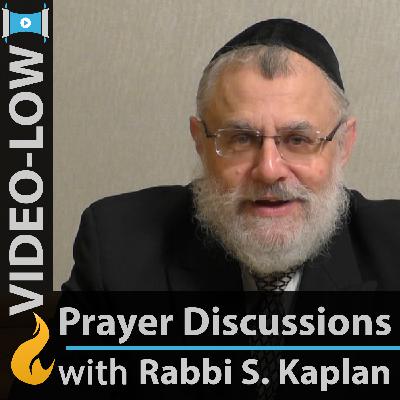Discover Discussions on Prayer
Discussions on Prayer

Discussions on Prayer
Author: Chabad.org
Subscribed: 12Played: 78Subscribe
Share
© 2025 Chabad.org - Chabad Lubavitch Media Center, all rights reserved
Description
We spend much time each day reciting the words of the siddur. Join us to enhance your prayers and become more proficient in understanding and mastering the prayer liturgy. This comprehensive series on Tefillah explores the special meaning embedded in the text of our prayers—elucidating, step by step, the words, structure, and progression of the siddur.
50 Episodes
Reverse
The popular prayer of ‘Aleinu’ – the final prayer – conveys the fundamental values of Judaism. Firstly, praise for being a unique people with a unique mission, the unique unity of G-d, and the hope for the time when G-d’s presence will be fully realized in the world.
Following the Amidah and the confessional prayers, we conclude with a number of additional prayers to supplement the service. We recite the prayer of Ashrei again, Psalm 20, the Sanctification of G-d, Song of the Day, and Ein Kelokeinu.
Following the culmination of the Amidah, we proceed to recite the prayers of supplication, which include confession of sins and asking for forgiveness, the “thirteen attributes of mercy”, and “falling on our faces” in submission with verses of supplication.
The final three blessings of the Amidah are centered on the theme of thanksgiving and acknowledgement to G-d. In this lesson we reach the conclusion of the Shemoneh Esrei.
An additional nineteenth blessing – asking G-d to reject those who corrupt our faith – was later inserted into the Amidah (as the 12th blessing). The blessing to uplift the righteous follows, and next are two blessings praying for the coming of Moshiach and redemption. The final intermediate blessing (the 16th) is the culmination of it all—requesting G-d to accept and listen to our prayers.
The intermediary blessings of the Amidah can be divided into two categories, individual requests and communal requests. In this class we examine the ninth to eleventh blessings, which are personal requests for prosperity and livelihood, and then collective requests for redemption.
The middle blessings of the Amidah consist of personal requests for our spiritual and physical needs. In this class we gain insight into the fifth to eighth blessings, which we ask G-d to return us, forgive us, redeem us, and grant us good health.
The third blessing of the Amidah corresponds to Jacob and extolls the awesome sanctity of G-d and His name. In the fourth blessing we ask for knowledge—this is the beginning of the next part of the Amidah, which are requests for our needs.
The second blessing of the Amidah corresponds to Yitzchak—the second patriarch, and focuses on G-d’s attribute of severity and might. We praise the Almighty for His power to grant life and for the resurrection of the dead.
The Amidah prayer begins with three blessings of praise that correspond to the three Patriarchs. The first blessing focuses on the special merit and quality of Abraham.
The silent prayer called the Amidah, also known as the “Shemoneh Esrei” (eighteen blessings), is the climax and highest rung on the ladder of prayer. Discover the significance and broader context of the Amidah, and why it contains 18 blessings.
The blessing following the Shema is an uninterrupted continuation, wherein we affirm the absolute truth of the Shema with fifteen different expressions. We validate the fulfillment of G-d’s promises of the past and declare our confidence in His salvation for the future—immediately prior to asking for our needs in the Amidah prayer.
The third section of the Shema contains the mitzvah of tzitzit, which serves as a reminder for our commitment to all of G-d’s mitzvahs, and not fall astray to our eyes and hearts temptations. It concludes with the remembrance of the exodus from Egypt.
The second paragraph of the Shema (v’hayah) restates and expands on elements of the first paragraph, but in markedly different form. Also, the Torah informs us of the ‘reward and punishment’ for mitzvah observance, warning us not to abandon them.
In the first paragraph of the Shema (v’Ahavta), after submitting to G-d’s sovereignty, we accept the yoke of His commandments. This begins with the instruction to love G-d, which motivates and energizes the performance of mitzvahs. This class also addresses the famous question of how G-d can expect us to love Him on command.
In this class we learn the deeper meaning of the verse “Shema Yisroel” (Hear O’ Israel), in which we bear witness to the oneness of G-d.
The central prayer of Shema Yisrael (Hear O Israel . . . G-d Is One) begins with the essential statement of Jewish faith, wherein we proclaim our absolute belief in one unified G-d. Discover profound insight into how the Shema stands at the epicenter of our existence and ultimately encapsulates our historic experience at Sinai.
The second blessing of the Shema begins with the words Ahavat Olam (an everlasting love), and highlights the special love G-d displays towards the Jew, which in turn arouses a love from the Jew to G-d.
There are two general classes of heavenly angels, one intellectual and the other emotional. In this lesson we discuss the distinction in the sanctification of G-d recited by these two categories of angels, and how this influences our declaration as well. We then proceed to conclude the first blessing of the Shema.
We recite in our prayers the angels’ sanctification of G-d. However, the angels first ask permission from one another and accept the yoke of heaven prior to sanctifying G-d. What is the meaning of the sanctification (holy, holy, holy…)?





